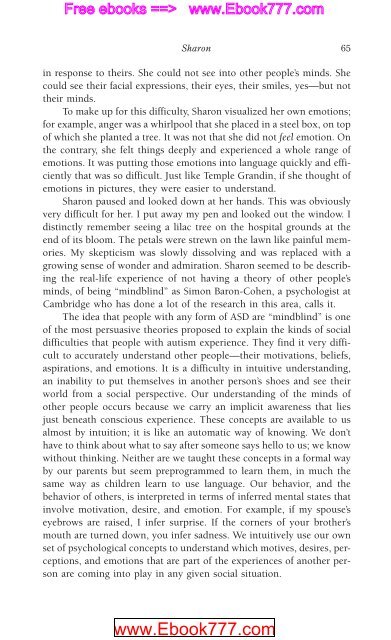978-1572305441
autism
autism
Create successful ePaper yourself
Turn your PDF publications into a flip-book with our unique Google optimized e-Paper software.
Free ebooks ==> www.Ebook777.com<br />
www.Ebook777.com<br />
Sharon 65<br />
in response to theirs. She could not see into other people’s minds. She<br />
could see their facial expressions, their eyes, their smiles, yes—but not<br />
their minds.<br />
To make up for this difficulty, Sharon visualized her own emotions;<br />
for example, anger was a whirlpool that she placed in a steel box, on top<br />
of which she planted a tree. It was not that she did not feel emotion. On<br />
the contrary, she felt things deeply and experienced a whole range of<br />
emotions. It was putting those emotions into language quickly and efficiently<br />
that was so difficult. Just like Temple Grandin, if she thought of<br />
emotions in pictures, they were easier to understand.<br />
Sharon paused and looked down at her hands. This was obviously<br />
very difficult for her. I put away my pen and looked out the window. I<br />
distinctly remember seeing a lilac tree on the hospital grounds at the<br />
end of its bloom. The petals were strewn on the lawn like painful memories.<br />
My skepticism was slowly dissolving and was replaced with a<br />
growing sense of wonder and admiration. Sharon seemed to be describing<br />
the real-life experience of not having a theory of other people’s<br />
minds, of being “mindblind” as Simon Baron-Cohen, a psychologist at<br />
Cambridge who has done a lot of the research in this area, calls it.<br />
The idea that people with any form of ASD are “mindblind” is one<br />
of the most persuasive theories proposed to explain the kinds of social<br />
difficulties that people with autism experience. They find it very difficult<br />
to accurately understand other people—their motivations, beliefs,<br />
aspirations, and emotions. It is a difficulty in intuitive understanding,<br />
an inability to put themselves in another person’s shoes and see their<br />
world from a social perspective. Our understanding of the minds of<br />
other people occurs because we carry an implicit awareness that lies<br />
just beneath conscious experience. These concepts are available to us<br />
almost by intuition; it is like an automatic way of knowing. We don’t<br />
have to think about what to say after someone says hello to us; we know<br />
without thinking. Neither are we taught these concepts in a formal way<br />
by our parents but seem preprogrammed to learn them, in much the<br />
same way as children learn to use language. Our behavior, and the<br />
behavior of others, is interpreted in terms of inferred mental states that<br />
involve motivation, desire, and emotion. For example, if my spouse’s<br />
eyebrows are raised, I infer surprise. If the corners of your brother’s<br />
mouth are turned down, you infer sadness. We intuitively use our own<br />
set of psychological concepts to understand which motives, desires, perceptions,<br />
and emotions that are part of the experiences of another person<br />
are coming into play in any given social situation.



